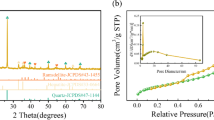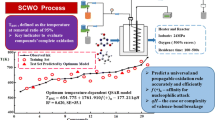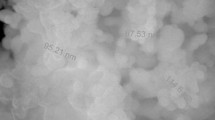Abstract
Manganese dioxide formed in oxidation process by potassium permanganate exhibits promising adsorptive capacity which can be utilized to remove organic pollutants in wastewater. However, the structure variances of organic molecules lead to wide difference of adsorption efficiency. Therefore, it is of great significance to find a general relationship between removal rate of organic compounds and their quantum parameters. This study focused on building up quantitative structure activity relationship (QSAR) models based on experimental removal rate (r exp) of 25 organic compounds and 17 quantum parameters of each organic compounds computed by Gaussian 09 and Material Studio 6.1. The recommended model is r pre = −0.502 − 7.742 f(+)x + 0.107 E HOMO + 0.959 q(H+) + 1.388 BO x. Both internal and external validations of the recommended model are satisfied, suggesting optimum stability and predictive ability. The definition of applicability domain and the Y-randomization test indicate all the prediction is reliable and no possibility of chance correlation. The recommended model contains four variables, which are closely related to adsorption mechanism. f(+)x reveals the degree of affinity for nucleophilic attack. E HOMO represents the difficulty of electron loss. q(H+) reflect the distribution of partial charge between carbon and hydrogen atom. BO x shows the stability of a molecule.

Similar content being viewed by others
References
Acelas NY, Mejia SM, Mondragón F, Flórez E (2013) Density functional theory characterization of phosphate and sulfate adsorption on Fe-(hydr)oxide: reactivity, pH effect, estimation of Gibbs free energies, and topological analysis of hydrogen bonds. Comput Theor Chem 1005:16–24
Aguayo-Villarreal IA, Hernández-Montoya V, Rangel-Vázquez NA, Montes-Morán MA (2014) Determination of QSAR properties of textile dyes and their adsorption on novel carbonaceous adsorbents. J Mol Liq 196:326–333
Aksu Z (2005) Application of biosorption for the removal of organic pollutants: a review. Process Biochem 40:997–1026
Andrade CH, Pasqualoto KF, Ferreira EI, Hopfinger AJ (2010) 4D-QSAR: perspectives in drug design. Molecules 15:3281–3294
Ayers PW, Morrison RC, Roy RK (2002) Variational principles for describing chemical reactions: condensed reactivity indices. J Chem Phys 116:8731
Balawender R, Geerlings P (2001) Nuclear Fukui function from coupled perturbed Hartree–Fock equations. J Chem Phys 114:682
Bhatnagar A, Hogland W, Marques M, Sillanpää M (2013) An overview of the modification methods of activated carbon for its water treatment applications. Chem Eng J 219:499–511
Blair BD, Crago JP, Hedman CJ, Treguer RJ, Magruder C, Royer LS, Klaper RD (2013) Evaluation of a model for the removal of pharmaceuticals, personal care products, and hormones from wastewater. Sci Total Environ 444:515–521
Dash S, Patel S, Mishra BK (2009) Oxidation by permanganate: synthetic and mechanistic aspects. Tetrahedron 65:707–739
Eddy NO, Ebenso EE (2010) Adsorption and quantum chemical studies on cloxacillin and halides for the corrosion of mild steel in acidic medium. Int J Electrochem Sci 5:731–750
Golbrakih A, Tropsha A (2002) Beware of q2 ! J Mol Graph Model 20:269–276
Gramatica P (2007) Principles of QSAR models validation: internal and external. QSAR Comb Sci 26:694–701
Kusic H, Rasulev B, Leszczynska D, Leszczynski J, Koprivanac N (2009) Prediction of rate constants for radical degradation of aromatic pollutants in water matrix: a QSAR study. Chemosphere 75:1128–1134
Li XD, Schwartz FW (2004) DNAPL remediation with in situ chemical oxidation using potassium permanganate. J Contam Hydrol 68:39–53
Liu R, Liu H, Zhao X, Qu J, Zhang R (2010) Treatment of dye wastewater with permanganate oxidation and in situ formed manganese dioxides adsorption: cation blue as model pollutant. J Hazard Mater 176:926–931
Lofrano G, Meric S, Zengin GE, Orhon D (2013) Chemical and biological treatment technologies for leather tannery chemicals and wastewaters: a review. Sci Total Environ 461–462:265–281
Ma B, Chen H, Xu M, Hayat T, He Y, Xu J (2010) Quantitative structure-activity relationship (QSAR) models for polycyclic aromatic hydrocarbons (PAHs) dissipation in rhizosphere based on molecular structure and effect size. Environ Pollut 158:2773–2777
Melagraki G, Afantitis A (2013) Enalos KNIME nodes: exploring corrosion inhibition of steel in acidic medium. Chemom Intell Lab Syst 123:9–14
Melagraki G, Afantitis A (2014) Enalos InSilicoNano platform: an online decision support tool for the design and virtual screening of nanoparticles. RSC Adv 4:50713–50725
Mouchlis VD, Melagraki G, Mavromoustakos T, Kollias G, Afantitis A (2012) Molecular modeling on pyrimidine-urea inhibitors of TNF-alpha production: an integrated approach using a combination of molecular docking, classification techniques, and 3D-QSAR CoMSIA. J Chem Inf Model 52:711–723
Mustafa S, Zaman MI, Khan S (2006) pH effect on phosphate sorption by crystalline MnO(2). J Colloid Interface Sci 301:370–375
Myint KZ, Xie XQ (2010) Recent advances in fragment-based QSAR and multi-dimensional QSAR methods. Int J Mol Sci 11:3846–3866
Redding AM, Cannon FS, Snyder SA, Vanderford BJ (2009) A QSAR-like analysis of the adsorption of endocrine disrupting compounds, pharmaceuticals, and personal care products on modified activated carbons. Water Res 43:3849–3861
Stone AT, Morgan JJ (1984) Reduction and dissolution of managese (IV) oxides by organics: 2. Survey of the reactivity of organids. Environ Sci Technol 18:617–624
Topliss JG, Edwards RP (1979) Chance factors in studies of quantitative structure-activity relatiionships. J Med Chem 22:1238–1244
Tropsha A (2010) Best practices for QSAR model development, validation, and exploitation. Mol Inf 29:476–488
Xu M, Wang H, Lei D, Qu D, Zhai Y, Wang Y (2013) Removal of Pb(II) from aqueous solution by hydrous manganese dioxide: adsorption behavior and mechanism. J Environ Sci 25:479–486
Zhang S, Alexander G, Scott O, Alexander T (2006) A novel automated lazy learning QSAR (all-QSAR) approach: method development, application and virtual screening of chemical databases using validated all-QSAR models. J Chem Inf Model 46:1984–1995
Zhang L, Ma J, Yu M (2008) The microtopography of manganese dioxide formed in situ and its adsorptive properties for organic micropollutants. Solid State Sci 10:148–153
Zhang L, Ma J, Li X, Wang S (2009) Enhanced removal of organics by permanganate preoxidation using tannic acid as a model compound – Role of in situ formed manganese dioxide. J Environ Sci 21:872–876
Zhang Y, Wei D, Huang R, Yang M, Zhang S, Dou X, Wang D, Vimonses V (2011) Binding mechanisms and QSAR modeling of aromatic pollutant biosorption on Penicillium oxalicum biomass. Chem Eng J 166:624–630
Zhu H, Shen Z, Tang Q, Ji W, Jia L (2014) Degradation mechanism study of organic pollutants in ozonation process by QSAR analysis. Chem Eng J 255:431–436
Zhu H, Guo W, Shen Z, Tang Q, Ji W, Jia L (2015) QSAR models for degradation of organic pollutants in ozonation process under acidic condition. Chemosphere 119:65–71
Acknowledgments
This work was supported by the National Science Foundation of China (Project No. 21177083), and the program for New Century Excellent Talents in Shanghai Jiao Tong University.
Author information
Authors and Affiliations
Corresponding author
Additional information
Responsible editor: Marcus Schulz
Rights and permissions
About this article
Cite this article
Su, P., Zhu, H. & Shen, Z. QSAR models for removal rates of organic pollutants adsorbed by in situ formed manganese dioxide under acid condition. Environ Sci Pollut Res 23, 3609–3620 (2016). https://doi.org/10.1007/s11356-015-5569-1
Received:
Accepted:
Published:
Issue Date:
DOI: https://doi.org/10.1007/s11356-015-5569-1




